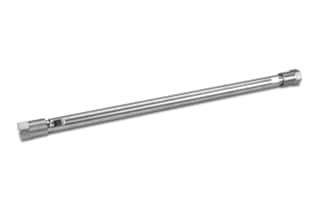
Waters Ultrahydrogel Columns contain a sophisticated aqueous-compatible gel column for analytical and preparative separations of water-soluble polymers. The gel is a cross-linked hydroxylated polymer and contains some residual carboxyl functionality. Ultrahydrogel DP contains some residual amine functionality. Compounds normally characterized include oligomers and biological substances such as polysaccharides, nucleic acids, proteins, and peptides.
|
Chemistry |
SEC |
|
Separation Mode |
Gel Filtration (aqueous) |
|
Particle Substrate |
Polymer |
|
pH Range Min |
2 pH |
|
pH Range Max |
12 pH |
|
Temperature Limits |
10 - 80C |
|
Molecular Weight Range Min |
5000 |
|
Molecular Weight Range Max |
400000 |
|
Particle Shape |
Spherical |
|
Particle Size |
10 µm |
|
Endfitting Type |
Waters |
|
Pore Size |
500 Å |
|
Format |
Column |
|
Packing Solvent |
Water |
|
System |
HPLC |
|
Technique |
SEC |
|
USP Classification |
L39 |
|
Inner Diameter |
7.8 mm |
|
Length |
300 mm |
|
UNSPSC |
41115709 |
|
Application |
Gel Filtration |
|
Brand |
Ultrahydrogel |
|
Product Type |
Columns |
|
Units per Package |
1 pk |

Ultrahydrogel Column, 500Å, 10 µm, 7.8 mm X 300 mm, 5K - 400K, 1/pk
Add the sophisticated aqueous-compatible gel Waters Ultrahydrogel Column to your lab as it is ideally suited for analytical and preparative separations of water-soluble polymers. The lab equipment uses a gel that is a cross-linked hydroxylated polymer containing some residual amine functionality. Using the Ultrahydrogel Column, you can characterize a large range of compounds, including oligomers, oligosaccharides, and biological substances like polysaccharides, nucleic acids, proteins, and peptides. Additionally, you can also characterize cationic, anionic, as well as amphoteric polymers.
The Ultrahydrogel Column listed here measures 7.8 x 300 mm. Its high resolution is superior to other conventional aqueous SEC Columns available in the market. The analytical column offers a wide working pH range of 2-12. In addition to this, you get greater flexibility for the mobile phase while causing minimal non-size exclusion effects. The Ultrahydrogel Column offers compatibility with high concentrations of organic solvents (up to 20% organic, 50% organic when the mobile phase is introduced by the gradient).
Use the Ultrahydrogel Column to get high resolution, low adsorption, and a wide range of molecular weight separations within a temperature range of 10 C to 80 C.
Like all our lab equipment, the Ultrahydrogel Column is manufactured in Waters ISO 9001 certified manufacturing facility using pure reagents and the strictest controls. Each column undergoes several tests to ensure its reliability. The column is certified for its use, making certain that it will continue to deliver optimal performance, and enhance the selectivity, sensitivity, and speed of your analysis.
Learn more about our manufacturing processes and the research and development we invest in to make our products the industry leaders they are. This literature is available on our website which also enables you to shop for lab equipment directly from us. Purchasing directly from Waters will ensure that you receive only authentic and original Waters equipment, at the best available price.
You may also want to explore the Ultrahydrogel Guard Column, 125Å, 6 µm, 6 mm X 40 mm, 1K - 500K, 1/pk, which is designed to enhance your column’s life.
What Impacts Column efficiency?
As Liquid chromatography columns have a finite life, it is important that they receive care and deliberation in use. A number of factors influence the column’s life. It is influenced by the number of injections, sample and solvent cleanliness, frequency of solvent changeover, and handling and storage procedures.